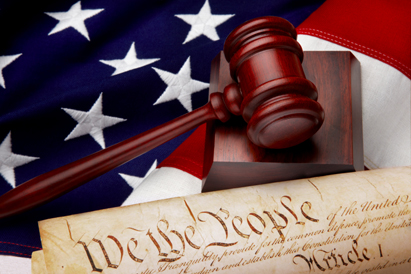Learn It
An author uses the written word to share his or her point of view or perspective (opinions and beliefs). After reading excerpts from two different Supreme Court rulings, compare the two authors’ points of view regarding the Fourteenth Amendment.
Read an excerpt from the majority opinion in Plessey v. Ferguson, a landmark 1896 United States Supreme Court decision.

Interpretation of text influences the perspective or point of view.
"The object of the [Fourteenth] Amendment was undoubtedly to enforce the absolute equality of the two races before the law, but in the nature of things it could not have been intended to abolish distinctions based upon color, or to enforce social, as distinguished from political, equality, or a commingling of the two races upon terms unsatisfactory to either."
- Justice Henry Billings Brown, speaking for the majority, 1896
The Plessy v. Ferguson interpretation of the Fourteenth Amendment became known as the “separate but equal” doctrine that allowed segregation in public facilities. In 1954, this doctrine was challenged by the court case Brown v. Board of Education. Read an excerpt from Chief Justice Earl Warren in the Brown v. Board of Education decision.
"We must look instead to the effect of segregation itself on public education…
Today, education is perhaps the most important function of state and local governments…In these days, it is doubtful that any child may reasonably be expected to succeed in life if he is denied the opportunity of an education. Such an opportunity, where the state has undertaken to provide it, is a right which must be made available to all on equal terms…
To separate them [children in grade and high schools] from others of similar age and qualifications solely because of their race generates a feeling of inferiority as to their status in the community that may affect their hearts and minds in a way unlikely to ever be undone… Whatever may have been the extent of psychological at the time of Plessy v. Ferguson, this finding is amply supported by modern authority. . . .
We conclude that in the field of public education the doctrine of "separate but equal" has no place. Separate educational facilities are inherently unequal. Therefore, we hold that the plaintiffs and other similarly situated … are … deprived of the equal protection of the laws guaranteed by the Fourteenth Amendment.”- Chief Justice Earl Warren, 1954
Understanding the author's point of view helps you comprehend what you are reading. When different authors have different points of view about the same topic, it helps to compare and contrast their opposing points of view. Let’s compare the two authors’ points of view regarding the Fourteenth Amendment.
Court Interpretations of the Fourteenth Amendment |
|
|---|---|
Plessy v. Ferguson – Majority Opinion by Justice Henry Brown |
Brown v. Board of Education - Unanimous Opinion by Earl Warren |
It guarantees only equal political rights. |
It applies to both political and social equality. |
It never intended to abolish social distinction based on race. |
It intended to abolish social distinctions based on race. |
It was not intended to end social segregation because there are no harmful effects. |
It intended to end social segregation because of its harmful effects. |
As you can see in the chart, two Supreme Court justices had widely opposing points of view about the intent and purpose of the Fourteenth Amendment and the issue of segregation.
Let’s watch three videos to compare the two authors’ points of view regarding the Fourteenth Amendment.
Now watch a video of the second interpretation of the Fourteenth Amendment.
Now watch a video of the third interpretation of the Fourteenth Amendment.








